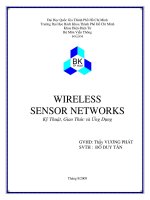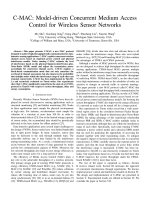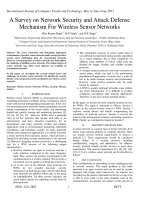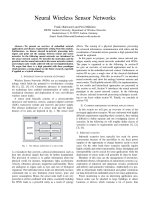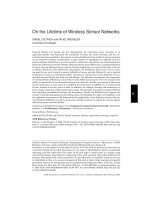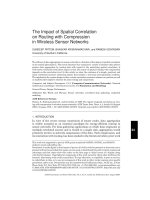Wireless networks - Lecture 34: Wireless sensor networks
Bạn đang xem bản rút gọn của tài liệu. Xem và tải ngay bản đầy đủ của tài liệu tại đây (509.38 KB, 31 trang )
Wireless Networks
Lecture 34
Wireless Sensor Networks Part I
Dr. Ghalib A. Shah
1
Outline
Introduction to WSN
Applications of WSN
Factors Influencing Performance of WSN
► Power consumption, fault tolerance, scalability, topology,
cost
Architecture and Communication Protocols
Challenges in WSNs.
2
Last Lecture Review
Motivation
►
TCP Variants
►
►
Slow start
Fast Retransmit/Recovery (TCP Reno)
Issues in Heterogeneous Wireless Networks
►
Fixed-end systems, fixed wired network, window-based, slow-start,
loss-based congestion control
BER, Bandwidth, variable RTT, Mobility, Power
TCP Schemes for Wireless
►
►
►
►
►
Revolve around distinguishing congestion loss, error loss, delay
bounds, dup Acks
Pure Link-level Approaches (FEC/ARQ)
Soft-state Transport Layer Caching Approaches (SNOOP)
Soft-state Cross Layer Signalling Approaches (ECN, EBSN, ELN,
ATCP)
Hard-state Transport Layer Approaches (I-TCP, Mobile TCP)
3
Introduction to WSNs
A sensor network is composed of a large number of
sensor nodes, which are densely deployed either inside
the phenomenon or very close to it.
Features:
►
►
►
►
Random deployment
Self-organizing
Cooperative capabilities
Local computation
4
What is a Sensor ?
Sensor is a small sized,
low power, low cost,
Micro-ElectroMechanical Systems
(MEMS)
which is capable of
sensing, computing and
communicating.
Processor Speed
8 MHz
Flash
512K bytes
SRAM
8k bytes
Radio Frequency
916 MHz/ 2.4 GHz (ISM)
Data Rate
40 Kbits/Sec (Max)
Radio Range
100 feet
Power
2 x AA batteries
5
Open Experimental Platform
Telos 4/04
Robust
Low Power
250kbps
Easy to use
Services
Networking
TinyOS
WeC 99
“Smart Rock”
Rene 11/00
Dot 9/01
Small
microcontroller
8 kB code
512 B data
Simple, low-power
radio
10 kbps ASK
Designed for
experimentation
EEPROM (32 KB)
-sensor boards
Simple sensors
-power boards
Demonstrate
scale
Mica 1/02
Mica2 12/02
38.4kbps radio
FSK
NEST open exp. Platform
128 kB code, 4 kB data
40kbps OOK/ASK radio
512 kB Flash
Commercial Off The Shelf Components (COTS)
6
Spec 6/03
“Mote on
a chip”
Introduction
Sensor networks VS ad hoc networks:
Scalability
►
Deployment
►
Sensor nodes mainly use broadcast, most ad hoc networks are based on
p2p.
Power Limitation
►
The topology of a sensor network changes very frequently?
Communication Paradigm
►
Sensor nodes are prone to failures.
Highly Dynamic topology
►
Sensor nodes are densely deployed.
Failure Rate
►
The number of nodes in a sensor network can be several orders of
magnitude higher than the nodes in an ad hoc network.
Sensor nodes are limited in power, computational capacities and
memory.
Unique IDs
►
Sensor nodes may not have global ID.
7
Applications of sensor networks
temperature
humidity
vehicular movement
lightning condition
pressure
soil makeup
noise levels
the presence or absence of certain kinds of
objects
8
Applications of sensor networks (Cntd.)
Military applic atio ns
►
►
►
►
►
Monitoring friendly forces, equipment and ammunition
Battlefield surveillance
Reconnaissance of opposing forces and terrain
Battle damage assessment
Nuclear, biological and chemical attack detection and
reconnaissance
Environmental applications
►
►
►
►
Forest fire detection
Biocomplexity mapping of the environment
Flood detection
Precision agriculture
9
Applications of sensor networks (Cntd.)
Health applications
► Telemonitoring of human physiological data
► Tracking and monitoring patients and doctors inside
a hospital
► Drug administration in hospitals
Home applications
► Home automation
► Smart environment
10
Applications of sensor networks
Other commercial applications
Environmental control in office buildings
Interactive museums
Managing inventory control
Vehicle tracking and detection
Detecting and monitoring car thefts
11
Factors influencing sensor network design
Fault tolerance
►
►
Fault tolerance is the ability to sustain sensor network
functionalities without any interruption due to sensor node
failures.
The fault tolerance level depends on the application of the
sensor networks.
Scalability
►
►
Scalability measures the density of the sensor nodes.
Density = (R) = (N
R 2)/A
Production costs
►
►
The cost of a single node is very important to justify the overall
cost of the networks.
The cost of a sensor node is a very challenging issue given the
amount of functionalities with a price of much less than a dollar.
12
Factors influencing sensor network design
Hardware constraints
13
Factors influencing sensor network design
Sensor network topology
► Pre-deployment and deployment phase
► Post-deployment phase
► Re-deployment of additional nodes phase
Power consumption
► Sensing
► Communication
• 3000 instructions can be executed for the same energy cost
of sending a bit 100m by radio.
► Data processing
14
Energy Consumption
Sensor node has limited energy supply
Nodes may not be rechargeable
3000 instructions can be executed for the same energy cost of sending a
bit 100m by radio.
20
Power (mW)
15
10
5
0
Sensing CPU
TX
R
IDLE SLEE
X
P
Power consumption of a typical senor node
15
Factors influencing sensor network design
Environment
Busy intersections
Interior of a large machinery
Bottom of an ocean
Inside a twister
Biologically or chemically contaminated field
Battlefield beyond the enemy lines
Home or a large building
Large warehouse
Fast moving vehicles
Drain or river moving with current.
16
Communication architecture of sensor
networks
17
Communication architecture of sensor
networks
18
Protocol Stack
Power Management Plan
►
►
Mobility Management Plan
►
Turning off the receiver after a msg is received from neighbor in order
to avoid getting duplicate msg and conserving energy.
Informing neighbor nodes during low battery power.
The mobility management plane detects and registers the movement
of sensor nodes, so a route back to the user is always maintained, and
the sensor nodes can keep track of who are their neighbor sensor
nodes.
Task Management Plan
►
The task management plane balances and schedules the sensing
tasks given to a specific region. Not all sensor nodes in that region are
required to perform the sensing task at the same time. As a result,
some sensor nodes perform the task more than the others depending
on their power level.
19
Communication architecture of sensor
networks
Application layer
► An application layer management protocol makes the hardware
and software of the lower layers transparent to the sensor
network management applications.
► Sensor management protocol (SMP)
► Task assignment and data advertisement protocol (TADAP)
► Sensor query and data dissemination protocol (SQDDP)
Transport layer
► This layer is especially needed when the system is planned to
be accessed through Internet or other external networks.
► No attempt thus far to propose a scheme or to discuss the
issues related to the transport layer of a sensor network in
literature.
20
Communication architecture of sensor
networks
Network layer
Power efficiency is always an important consideration.
Sensor networks are mostly data centric.
Data aggregation is useful only when it does not hinder
the collaborative effort of the sensor nodes.
An ideal sensor network has attribute-based addressing
and location awareness.
21
Communication architecture of sensor
networks
•Maximum available power (PA) route:
Route 2
•Minimum energy (ME) route: Route 1
•Minimum hop (MH) route: Route 3
•Maximum minimum PA node route:
Route 3
•Minimum longest edge route: Route 1
22
Communication architecture of sensor
networks
Data aggregation
23
Communication architecture of sensor
networks
Data link layer
► The data link layer is responsible for the medium access and
error control. It ensures reliable point-to-point and point-tomultipoint connections in a communication network.
Medium access control
► Creation of the network infrastructure
► Fairly and efficiently share communication resources between
sensor nodes
Power saving modes of operation
► Operation in a power saving mode is energy efficient only if the
time spent in that mode is greater than a certain threshold.
24
Communication architecture of sensor
networks
Error control
Forward Error Correction (FEC)
Automatic Repeat Request (ARQ).
Simple error control codes with low-complexity
encoding and decoding might present the best
solutions for sensor networks.
25
